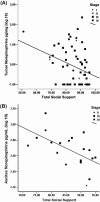Social isolation is associated with elevated tumor norepinephrine in ovarian carcinoma patients
- PMID: 20955777
- PMCID: PMC3103818
- DOI: 10.1016/j.bbi.2010.10.012
Social isolation is associated with elevated tumor norepinephrine in ovarian carcinoma patients
Abstract
Noradrenergic pathways have been implicated in growth and progression of ovarian cancer. Intratumoral norepinephrine (NE) has been shown to increase with stress in an animal cancer model, but little is known regarding how tumor NE varies with disease stage and with biobehavioral factors in ovarian cancer patients. This study examined relationships between pre-surgical measures of social support, depressed mood, perceived stress, anxiety, tumor histology and tumor catecholamine (NE and epinephrine [E]) levels among 68 ovarian cancer patients. We also examined whether associations observed between biobehavioral measures and tumor catecholamines extended to other compartments. Higher NE levels were found in advanced stage (p=0.006) and higher grade (p=0.001) tumors. Adjusting for stage, grade, and peri-surgical beta blockers, patients with a perceived lack of social support had significantly higher tumor NE (β=-0.29, p=0.012). A similar trend was seen for social support and ascites NE (adjusting for stage, peri-surgical beta blockers and caffeine: β=-0.50, p=0.075), but not for plasma NE. Other biobehavioral factors were not related to tumor, ascites, or plasma NE (p values >0.21). Tumor E was undetectable in the majority of tumors and thus E was not further analyzed. In summary, these results suggest that tumor NE provides distinct information from circulating plasma concentrations. Tumor NE levels were elevated in relationship to tumor grade and stage. Low subjective social support was associated with elevated intratumoral NE. As beta-adrenergic signaling is related to key biological pathways involved in tumor growth, these findings may have implications for patient outcomes in ovarian cancer.
Copyright © 2010 Elsevier Inc. All rights reserved.
Figures


References
-
- Aguado LI. Role of the central and peripheral nervous system in the ovarian function. Microsc. Res. Tech. 2002;59:462–473. - PubMed
-
- Ben-Jonathan N, Arbogast LA, Rhoades TA, Bahr JM. Norepinephrine in the rat ovary: ontogeny and de novo synthesis. Endocrinology. 1984;115:1426–1431. - PubMed
-
- Cacioppo JT, Hughes ME, Waite LJ, Hawkley LC, Thisted RA. Loneliness as a specific risk factor for depressive symptoms: cross-sectional and longitudinal analyses. Psychol Aging. 2006;21:140–51. - PubMed
-
- Chida Y, Hamer M, Wardle J, Steptoe A. Do stress-related psychosocial factors contribute to cancer incidence and survival? Nat. Clin. Pract. Oncol. 2008;5 - PubMed
Publication types
MeSH terms
Substances
Grants and funding
- R01 CA109298/CA/NCI NIH HHS/United States
- R01 CA110793/CA/NCI NIH HHS/United States
- R01 CA104825/CA/NCI NIH HHS/United States
- P50 CA083639/CA/NCI NIH HHS/United States
- R21 CA088293/CA/NCI NIH HHS/United States
- P50CA083639/CA/NCI NIH HHS/United States
- R01 CA140933/CA/NCI NIH HHS/United States
- CA140933/CA/NCI NIH HHS/United States
- CA116778/CA/NCI NIH HHS/United States
- CA109298/CA/NCI NIH HHS/United States
- R01 CA116778/CA/NCI NIH HHS/United States
- CA110793/CA/NCI NIH HHS/United States
- CA104825/CA/NCI NIH HHS/United States
LinkOut - more resources
Full Text Sources
Other Literature Sources
Medical
Research Materials

